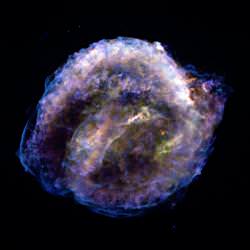 NASA’s Chandra X-Ray Observatory has created this amazing image of one of the youngest supernova remnants in the galaxy. The supernova that created it blazed in the sky more than 400 years ago, before the telescope had even been invented. No problem, though, it was bright enough that you didn’t need a telescope – it reached the brightness of Jupiter at its peak. And one of the greatest astronomers in history, Johannes Kepler was there to see it.
NASA’s Chandra X-Ray Observatory has created this amazing image of one of the youngest supernova remnants in the galaxy. The supernova that created it blazed in the sky more than 400 years ago, before the telescope had even been invented. No problem, though, it was bright enough that you didn’t need a telescope – it reached the brightness of Jupiter at its peak. And one of the greatest astronomers in history, Johannes Kepler was there to see it.
Continue reading “A New View of Kepler’s Supernova Remnant”
Blizzard of Snowflake Particles Around a Young Star
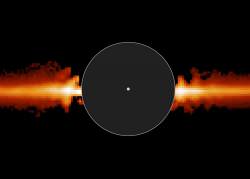 The Hubble Space Telescope has imaged a ring of dust around a nearby star that will probably become a system of planets. The star is AU Microscopii, and it’s located about 32 light-years away in the southern constellation of Microscopium (the Microscope). The particles are probably as fluffy as snowflakes, and about 10 times larger than typical interstellar dust grains.
The Hubble Space Telescope has imaged a ring of dust around a nearby star that will probably become a system of planets. The star is AU Microscopii, and it’s located about 32 light-years away in the southern constellation of Microscopium (the Microscope). The particles are probably as fluffy as snowflakes, and about 10 times larger than typical interstellar dust grains.
Continue reading “Blizzard of Snowflake Particles Around a Young Star”
On Some Planets, the Winds Go Supersonic
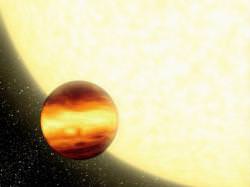 Think of the strongest wind you’ve ever experienced. No, think of the strongest wind anyone’s ever experienced. It still doesn’t hold a candle to the terrifyingly strong winds on some extrasolar planets. There are gas giants out there, with masses similar to Jupiter, that experience winds as strong as 14,400 kph (9,000 mph).
Think of the strongest wind you’ve ever experienced. No, think of the strongest wind anyone’s ever experienced. It still doesn’t hold a candle to the terrifyingly strong winds on some extrasolar planets. There are gas giants out there, with masses similar to Jupiter, that experience winds as strong as 14,400 kph (9,000 mph).
Continue reading “On Some Planets, the Winds Go Supersonic”
Hubble Helps Make a 3-D Map of Dark Matter
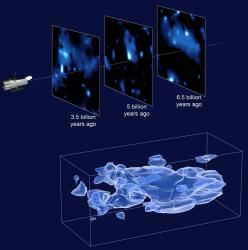 A team of astronomers has created a three-dimensional map of dark matter distribution across the Universe. This map gives some of the best evidence that normal matter, like you and me, stars and planets, accumulate around the densest regions of dark matter.
A team of astronomers has created a three-dimensional map of dark matter distribution across the Universe. This map gives some of the best evidence that normal matter, like you and me, stars and planets, accumulate around the densest regions of dark matter.
Continue reading “Hubble Helps Make a 3-D Map of Dark Matter”
Listening for ET
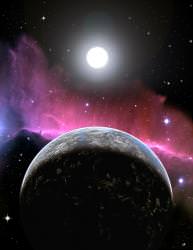 Are we alone in the Universe? We won’t know until we really start looking for life around other stars… or listening for it.
Are we alone in the Universe? We won’t know until we really start looking for life around other stars… or listening for it.
Continue reading “Listening for ET”
First Triple Quasar Discovered
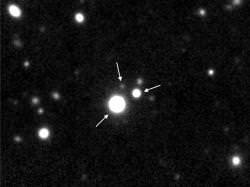 Quasars are some of the brightest objects in the Universe, beaming radiation across billions of light-years of space. Although they were a mystery for many years, astronomers now believe they’re the bright radiation from matter clogging up around an actively feeding supermassive black hole.
Quasars are some of the brightest objects in the Universe, beaming radiation across billions of light-years of space. Although they were a mystery for many years, astronomers now believe they’re the bright radiation from matter clogging up around an actively feeding supermassive black hole.
Continue reading “First Triple Quasar Discovered”
Gas Giants Turn Up Early After Star Formation
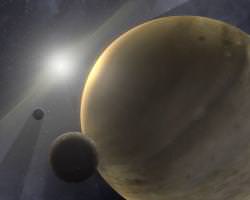 New research indicates that gas giants, like Jupiter and Saturn, form quickly after their stars do. In fact, they probably form within the first 10 million years of a star’s life, or else they never form at all.
New research indicates that gas giants, like Jupiter and Saturn, form quickly after their stars do. In fact, they probably form within the first 10 million years of a star’s life, or else they never form at all.
Continue reading “Gas Giants Turn Up Early After Star Formation”
Even Dwarf Galaxies Have Supermassive Black Holes
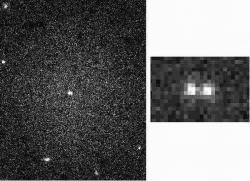 To form a supermassive black hole, you’d think it takes a really large galaxy, like the Milky Way or Andromeda. But it appears that these monsters can form at the heart of plain old dwarf galaxies too.
To form a supermassive black hole, you’d think it takes a really large galaxy, like the Milky Way or Andromeda. But it appears that these monsters can form at the heart of plain old dwarf galaxies too.
Continue reading “Even Dwarf Galaxies Have Supermassive Black Holes”
What’s Up this Week: January 8 – January 14, 2007
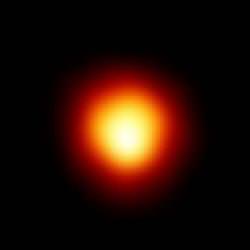
Greetings, fellow SkyWatchers! It’s time to take on the Hunter as we have a look at the Orion region for the unaided eye, binoculars and telescope. From Project Diana to the mightly Betelgeuse, it’s time to head for the stars because…
Here’s what’s up!
Monday, January 8 – On this day in 1942 – precisely 300 years after the death of Galileo, Stephen Hawking was born. The British theoretical astrophysicist, despite his physical limitations, became one of the world’s foremost leaders in cosmological theory and his book “A Brief History of Time” remains one of the best written on the subject.Also born on this day in 1587 was Johannes Fabricius, son of the discoverer of variable star Mira, David Fabricius. Like many father and son teams, the pair went on to study astronomy together, and some of their most frightening work dealt with viewing sunspots through an unfiltered telescope – a practice which eventually blinded Galileo!
Continue reading “What’s Up this Week: January 8 – January 14, 2007”
Book Review: Apollo – The Definitive Sourcebook
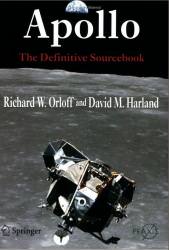 Our Moon has been visited by men, yet this fact may seem like fiction to many people. Over an incredibly short span, people of one nation came together, developed a technology and achieved the goal of walking on the lunar surface. For those wanting a reference for this momentous event, Richard Orloff and David Harland provide their book, Apollo – The Definitive Sourcebook. In it are the facts and figures regarding the events surrounding the people and hardware of this amazing achievement.
Our Moon has been visited by men, yet this fact may seem like fiction to many people. Over an incredibly short span, people of one nation came together, developed a technology and achieved the goal of walking on the lunar surface. For those wanting a reference for this momentous event, Richard Orloff and David Harland provide their book, Apollo – The Definitive Sourcebook. In it are the facts and figures regarding the events surrounding the people and hardware of this amazing achievement.
Continue reading “Book Review: Apollo – The Definitive Sourcebook”
